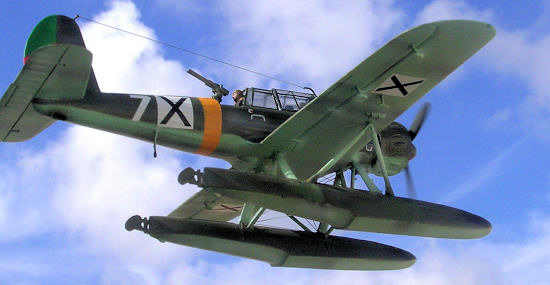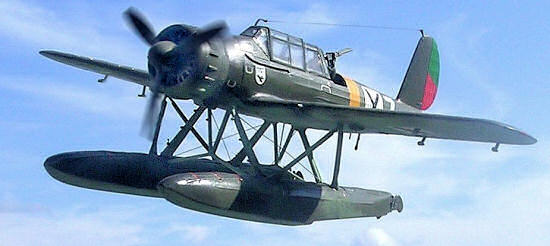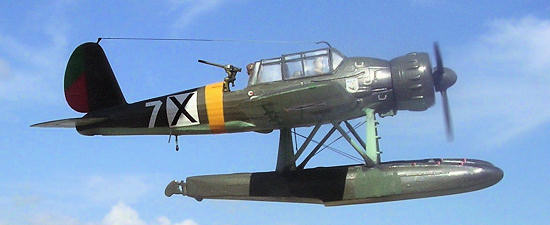The Arado 196 was designed
primarily to replace the Heinkel He-60 biplane floatplane, then currently in
service on all
Germany’s
capital ships. This was also one of the few seaplanes to see service in the
Atlantic
and th e
Mediterranean.
Its primary duties consisted of reconnaissance and shadowing of surface
vessels. Whereas in most respects the Ar-196 were relegated to sea patrols
from shore bases, about 50 Arado-196s served with Baltic Air Forces in the
Adriatic and Black Sea.
e
Mediterranean.
Its primary duties consisted of reconnaissance and shadowing of surface
vessels. Whereas in most respects the Ar-196 were relegated to sea patrols
from shore bases, about 50 Arado-196s served with Baltic Air Forces in the
Adriatic and Black Sea.
There were models
A, B, C originally built by Arado Flagzeugwerke GmbH and over 500 were
built. First flight took place in May 1938, and service delivery
August 1st 1939.
Arado 196A-3were powered by 9 cylinder radial BMW 132K engine of 960hp.
Arado 196A-0 was a pre production batch of 10 aircraft, fitted with bomb
racks and rear machine guns only. Arado 196A-1, a batch of 20 built in
1939for operations from major warships. These included Admiral Graf Spee,
Sharnhorst, Admiral Scheer, Prinz Eugen and Admiral Hipper. Arado 196A-2 was
a coastal patrol version. Arado 192A-2 and A-3 had twin MG FF 20mm cannons
in outer wings, one MG17 7.92mm in top decking, one 7.92MG 15 on pivot mount
aimed by observer. Arado 196 attained a speed of 193mph at 13,120 ft and a
cruising speed of 158mph. Service ceiling 22,960 ft and a range of 670 miles
at 158 mph. The Arado 196 was known for its rugged construction…see
http://www.youtube.com/watch?v=Vnhze7UiGbU
.
The plane
was loved by its pilots, who found it handled well both in the air and on
the water. With the loss of the German surface fleet the A-1s were added to
coastal squadrons, and continued to fly reconnaissance missions and
submarine hunts into late 1944. Two notable operations were the capture of
HMS Seal and the repeated interception of RAF Armstrong Whitworth
Whitley bombers. Although it was no match for a fighter, it was considerably
better than its allied counterparts, and generally considered the best of
its class. Owing to its good handling on water, the Finnish Air Force
utilized Ar 196 solely on transporting and supplying special forces patrols
behind enemy lines, landing on small lakes in remote areas. Several fully
equipped soldiers were carried in the fuselage.
of
its class. Owing to its good handling on water, the Finnish Air Force
utilized Ar 196 solely on transporting and supplying special forces patrols
behind enemy lines, landing on small lakes in remote areas. Several fully
equipped soldiers were carried in the fuselage.
Despite the fact that
Bulgaria
did not declare war on the
Soviet Union,
the only European Axis country not to do so, Soviet "shtuka" attack
submarines, as well as torpedo boats frequently assaulted Axis ships, layed
mines and bombed Bulgarian ports. In early 1943 the Tsardom of
Bulgaria
purchased 12 Ar-196A-3 floatplanes to replace its aging Letov S-328s, He-42s
and He-60s, used to escort Bulgarian and Axis convoys in the
Black Sea.
These ex-German Arado-196s were completely overhauled by German factories in
late 1942. The planes, bearing white numbers, were assigned to
161-во водосамолетно ято (161st
Coastal Yato-floatplane squadron) at the Chaika waterway. Their task was
mainly to hunt for submarines. The planes were in active wartime duty until
autumn 1944, and served in the Bulgarian Air Force until the late 40's. The
|Arado-196m Akula was among the best float-equipped reconnaissance fleet,
being right at the forefront of Vazdushni Voiski in the early 40s.
The Werknummern of the 12 aircraft are:
0219, 0244, 0245, 0247, 0252, 0253, 0255, 0256, 0257, 0258, 0261, 0262 . The
preserved aircraft at Varna is WNr.0219.
 The Arado 196 kit is a Heller mold although boxed in the Encore packing.
There is an improvement in decal sheet over the Heller original release. The
kit is molded in soft white acetate but has raised panel lines being one of
Heller early releases going back to mid 70s. It is accurate in shape though
there is presence of ejector pin marks on some parts, along with very little
flash. The cockpit office has a seat; control stick, rudder pedals and
instrument panel with raised dials, while another seat fitted at the back
for the observer operates a twin mount machine gun. Instructions are in
English and colors are listed in RLM numbers where appropriate. There are
markings for three aircraft: a Romanian AF, Bulgarian AF and a Luftwaffe
machine. These are all in RLM72 dark green upper and light blue grey RLM65
undersides with yellow RLM 04, axis recognition areas.
The Arado 196 kit is a Heller mold although boxed in the Encore packing.
There is an improvement in decal sheet over the Heller original release. The
kit is molded in soft white acetate but has raised panel lines being one of
Heller early releases going back to mid 70s. It is accurate in shape though
there is presence of ejector pin marks on some parts, along with very little
flash. The cockpit office has a seat; control stick, rudder pedals and
instrument panel with raised dials, while another seat fitted at the back
for the observer operates a twin mount machine gun. Instructions are in
English and colors are listed in RLM numbers where appropriate. There are
markings for three aircraft: a Romanian AF, Bulgarian AF and a Luftwaffe
machine. These are all in RLM72 dark green upper and light blue grey RLM65
undersides with yellow RLM 04, axis recognition areas.
e
Building the kit was fun and this was considered as a fast build. I have plans
to add another Bulgarian Ar-196 with a difference in the markings as it carried
3 different types of national insignia signifying the period when the type
served in Bulgaria. If one missed the Heller kit then the Encore is highly
recommended. It was now time to picture the Arado flying on one of the bays
around.